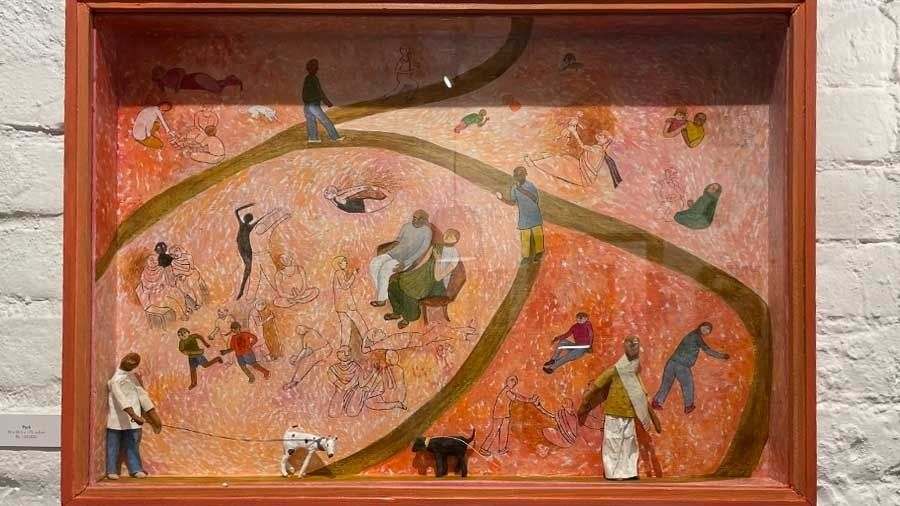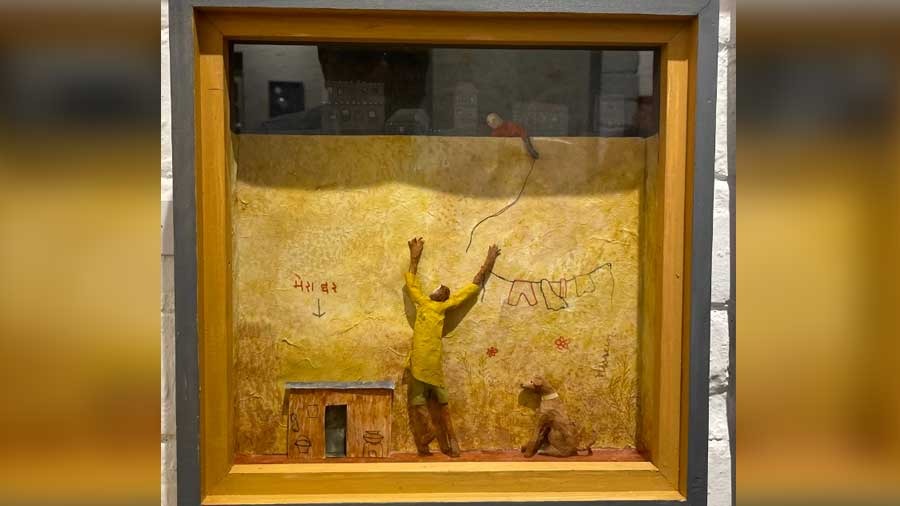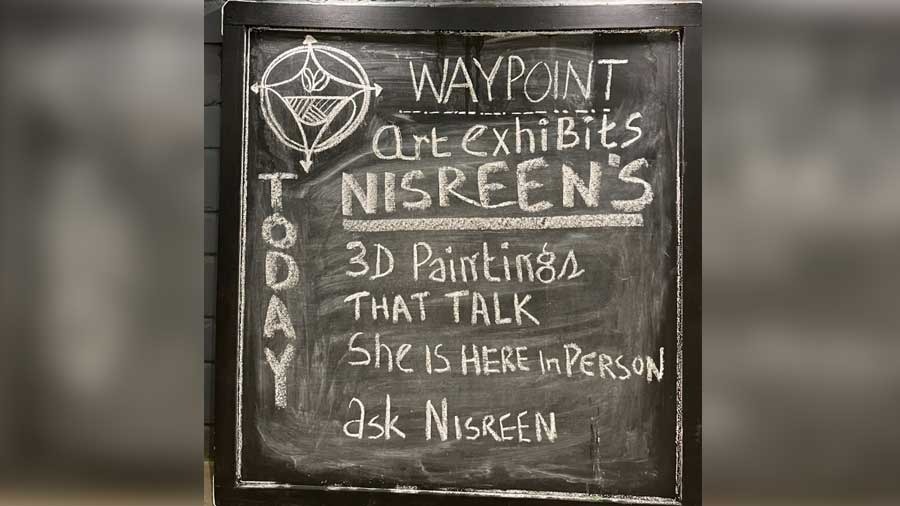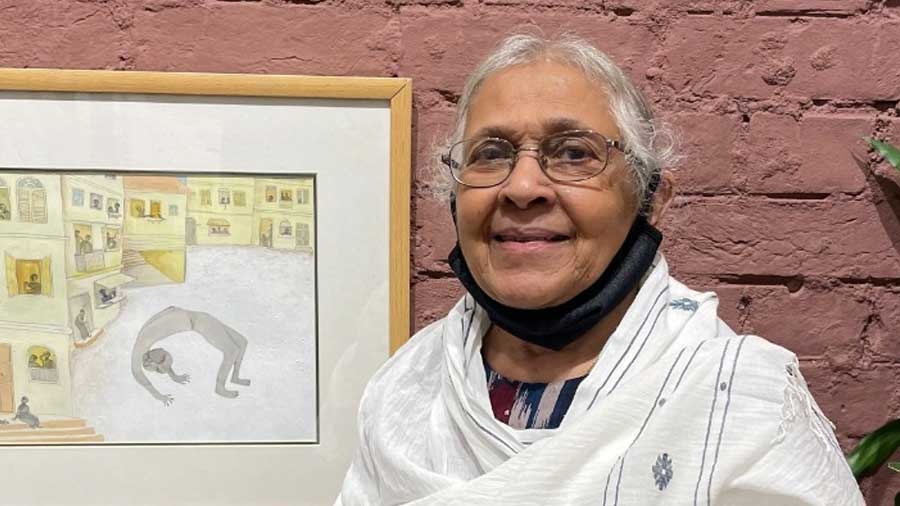Why an exhibition now, and at 86?
Nisreen Moochhala: A few good reasons. The pandemic gave me considerable time to paint in enforced solitude. The months spent in silence and loneliness could otherwise have affected one’s sanity but for the fact that one was engrossed in painting. Now that the vaccinations have increased and the pandemic shows signs of receding, it is time to step out and present one’s work. This explains the ‘why now’ part of your question.
As far as the question of age is concerned, painting is one passion that one can take into the eighties and nineties because one can sit and paint as well. The fact that I am 86 is a coincidence; I don’t feel intimidated by this number to stop painting in anticipation of weariness. On the contrary, the passion for painting has proved therapeutic.
I sometimes paint right through the day. It’s in the blood, so to speak; if one does not paint, one feels frustrated and gets the feeling that something is wrong with one’s system. That brings one to an interesting reality: the longer one takes to paint, the more fearful one becomes of whether the ideas will crystallise and translate attractively onto canvas. There would be times when I would stay fallow for days and then Taher, my husband, would teasingly ask ‘Dukaan natthi kholi?’

‘The fact that I am 86 is a coincidence; I don’t feel intimidated by this number to stop painting in anticipation of weariness. On the contrary, the passion for painting has proved therapeutic,’ says Nisreen
You came with a painting experience in Bombay and Surat. How did you take that ahead in Calcutta?
Let me give you a brief introduction to my background. I was born in 1935 and was educated at the Madresah Taiyebiyah in Surat where I stayed until my SSC examination. I am a good instance of one word from a teacher or principal making a life difference; in my case, Ms Cooper taking an interest in my painting skills and saying ‘I would have put you into JJ’, which meant that she felt that my interests would be better served if I joined the JJ School of Art in Bombay!
My parents felt that I should move out to take my education ahead and the result was that I was enrolled in St Xavier’s College in Bombay. The cultural difference became immediately evident, having come from Surat where the medium of conversation for engagement was Gujarati. I completed a year-and-a-half at the college before I moved to the Model Art Institute in Dadar. Thereafter I enrolled at the JJ School of Art where I insisted that I possessed the competence to join from the second year. It may have sounded audacious for one seeking admission to a prestigious institution but as it turned out, I was given a test, passed it and moved directly into the second year.

Nisreen’s paintings on display at Waypoint Café in Sarat Bose Road
I ended up spending the next five years there, which may appear to be an eternity in today’s environment where students seek to monetise their education with speed and start repaying their educational loans. After I completed the four years left for a diploma course, I enrolled for a post-diploma course. Once this was finally complete, I felt I possessed reasonable competence in the following subjects – life, still life, design, composition, live model and anatomy. I was ready for the world!
How did you monetise your competence?
I tried for a job. There was a design centre at Handloom House (Evans Fraser) across Badri Mahal in Bombay. I was interviewed by the famous Pupul Jayakar no less, who liked my work and asked if I was open to a transferable job. I was doba (stupid); I declined. That engagement did not work out but what did transpire was that I was engaged with Taher in Calcutta soon after. So even as I was approved for the post of a commercial and applied artist in an advertising company in Bombay, there was a rethink on the subject. I married in 1958 and moved to Calcutta in 1959.

Another of Nisreen’s paintings, titled ‘Park’
How did you take your career ahead in Calcutta?
Life is full of coincidences. In my case, I ran into painter Toofan Rafai, who had worked in the Design Service Centre in Mumbai and had now been transferred to Calcutta. He had been a senior to me at JJ School of Art. The result is that we collaborated to host our first painting exhibition at the Academy of Fine Arts. Not one canvas was sold!
The next milestone was when I encountered Jeram Patel in Calcutta, a prominent painter from the Baroda School of Art. He would provoke me ‘Why do you need to paint’, referring to a financially comfortable family background and children to take care of. What Jeram did was something I will not forget; he brought a canvas home with the words ‘Use it or throw it!’ One of the days he came home, he brought the prominent painter Manu Parekh with him; Manu, in turn, brought Madhvi with him. With this encouragement, there was no alternative but to paint. I did a handful of shows at Birla Academy, two or three were solo but the net result would be usually the same: one would sit at the gallery the entire day and hardly anyone would come to see the work and no canvas would be sold. When my two children were a bit older and would spend the large part of their day at school, I realised that it was time I worked professionally.
The result is that I started teaching art at Modern High School, a stint that continued for nearly a quarter of a century.

A work titled ‘The Wall’
Why then did you shift to Pune?
Taher and his brothers closed their shop SA Moochhala and Company on NS Road when they got older. At that time, we decided that the best thing to do would be to leave Calcutta as the building in which he lived in a rented apartment had become old. Taher would have liked to settle down in Surat but the tehzeeb of old had gone so we decided to settle down in Pune instead. That move suddenly brought my painting career alive all over again.
Which was your first break?
In Pune, I developed an interesting style: I began to paint inside boxes. There was a reason for this: I had once gone to visit my maid at her residence, which turned out to be less than 100 sq feet in space. That set me thinking: how could one live inside such a box? The word ‘box’ stayed in my subconscious. I created a box and decided to paint her life inside it. Thereafter, I began to use the box as a metaphor – not just of her life but for everything I saw in life. The box series became my style; this was completely new in India. People painted on canvases; the painting inside a box was completely fresh.
I placed some of my paintings in Tao Art Gallery in Worli (Mumbai) and one day when I went back to check, the proprietor gave me stunning news: ‘One sold!’ he said. I was delighted. When I returned a few weeks later, more paintings had been sold. What I noticed was that the smaller paintings had begun to sell faster. That gave me an insight into the market trend; in a subsequent exhibition, I put 40 canvases on display and was amazed that 20 were sold!

A beaming Nisreen
I still engage in box painting but for the last one-and-a-half years I haven’t been able to paint much due to the pandemic as boxes were not available.
I then started more shows; I moved to cities like Calcutta, Mumbai, Chennai, Pune and Surat. I extended from my signature box style to Arabic calligraphy where I sold 16 out of 24 canvases.
What is your routine on a day that you are painting?
I start painting in the afternoon and continue into the night (sometimes even after that). I don’t have any fixed routine. I paint for as long as I want. I mostly work on small paintings with intricate detail, which takes around 10-15 days, if I get it right, that is. If I am unable to get it right, then I put it away and resume after a month. I usually work on one painting at a time.
How long do you think you’ll continue painting?
As long as I can!

Nisreen Moochhala’s exhibition is on at Waypoint Café (Sarat Bose Road) till Sunday, December 26, from 11am to 10pm daily except Mondays.
